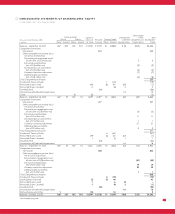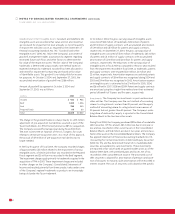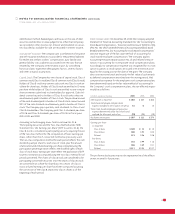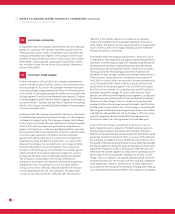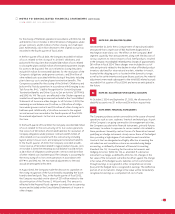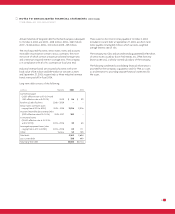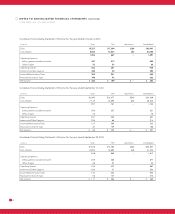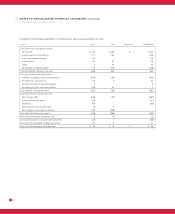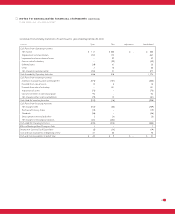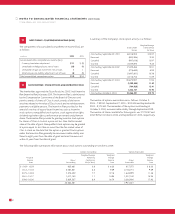Tyson Foods 2004 Annual Report Download - page 42
Download and view the complete annual report
Please find page 42 of the 2004 Tyson Foods annual report below. You can navigate through the pages in the report by either clicking on the pages listed below, or by using the keyword search tool below to find specific information within the annual report.
40
NOTES TO CONSOLIDATED FINANCIAL STATEMENTS (CONTINUED)
The Company had derivative related balances of $87 million and
$20 million recorded in other current assets at October 2, 2004,
and September 27, 2003, respectively, and $83 million and $37 million
in other current liabilities at October 2, 2004, and September 27,
2003, respectively.
The Company uses derivatives to moderate the
financial and commodity market risks of its business operations.
Derivative products, such as futures and option contracts, are
considered to be a hedge against changes in the amount of future
cash flows related to commodities procurement. The Company also
enters into interest rate swap agreements to adjust the proportion
of total long-term debt and leveraged equipment loans that are
subject to variable interest rates. Under these interest rate swaps,
the Company agrees to pay a fixed rate of interest times a notional
principal amount and to receive in return an amount equal to a
specified variable rate of interest times the same notional principal
amount. These interest rate swaps are considered to be a hedge
against changes in the amount of future cash flows associated with
the Company’s variable rate interest payments.
The effective portion of the cumulative gain or loss on the derivative
instrument is reported as a component of other comprehensive
income (loss) in shareholders’ equity and recognized into earnings
in the same period or periods during which the hedged transaction
affects earnings (for grain commodity hedges when the chickens that
consumed the hedged grain are sold). The remaining cumulative gain
or loss on the derivative instrument in excess of the cumulative
change in the present value of the future cash flows of the hedged
item, if any, is recognized in earnings during the period of change.
No ineffectiveness was recognized on cash flow hedges during
fiscal 2004, 2003 or 2002.
Derivative products related to grain procurement, such as futures
and option contracts that meet the criteria for SFAS No. 133 hedge
accounting, are considered cash flow hedges, as they hedge against
changes in the amount of future cash flows related to commodities
procurement. The Company applies SFAS No. 133 hedge accounting
to derivative products related to grain procurement that are hedg-
ing physical grain contracts that have previously been purchased.
The Company does not purchase derivative products related to grain
procurement in excess of its physical grain consumption requirements.
The Company expects that the after tax losses, net of gains, total-
ing approximately $22 million recorded in other comprehensive
income (loss) at October 2, 2004, related to cash flow hedges, will
be recognized within the next 12 months. The Company generally
does not hedge cash flows related to commodities beyond 12 months.
The Company’s open mark-to-market SFAS No. 133 hedge positions
were not significant as of October 2, 2004.
The Company designates certain futures contracts
as fair value hedges of firm commitments to purchase livestock for
slaughter and natural gas for the operation of its plants. From time
to time, the Company also enters into foreign currency forward
contracts to hedge changes in fair value of receivables and purchase
commitments arising from changes in the exchange rates of foreign
currencies; however, the Company has not entered into any such
contracts in fiscal years 2004 or 2003. Changes in the fair value of a
derivative that is highly effective and that is designated and qualifies
as a fair value hedge, along with the loss or gain on the hedged asset
or liability that is attributable to the hedged risk (including losses or
gains on firm commitments), are recorded in current period earnings.
Ineffectiveness results when the change in the fair value of the hedge
instrument differs from the change in fair value of the hedged item.
Ineffectiveness recorded related to the Company’s fair value hedges
was not significant during fiscal 2004, 2003 or 2002.
The Company holds positions as part of
its risk management activities, primarily certain grain and livestock
futures for which it does not apply SFAS No. 133 hedge accounting,
but instead marks these positions to fair value through earnings at
each reporting date. Changes in market value of derivatives used in
the Company’s risk management activities surrounding inventories
on hand or anticipated purchases of inventories are recorded in cost
of sales. Changes in market value of derivatives used in the Company’s
risk management activities surrounding forward sales contracts are
recorded in sales. The Company generally does not enter into
undesignated positions beyond 12 months.
Based on the Company’s evaluation of the grain markets, the Company
has at times entered into a portion of its derivative products related
to grain procurement prior to purchasing the physical grain contracts.
The Company has not applied SFAS No. 133 hedge accounting treat-
ment for these derivative positions. In connection with these risk
management activities, the Company recognized pretax net gains
of approximately $58 million and pretax net losses of approximately
$4 million in cost of sales for fiscal years ended October 2, 2004,
and September 27, 2003, respectively. The current year derivative
gains were due primarily to the increase in grain futures prices
during the second fiscal quarter and the Company having a higher
number of derivative positions in place at that time as compared
to the same period in the prior year.



